Furo and the Maekawarake
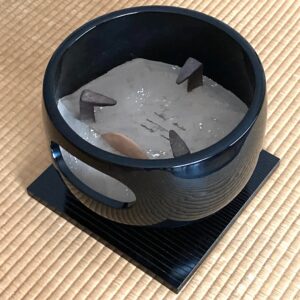
Mayu bu-ro, 眉風炉, eyebrow wind-hearth, with trivet, go-toku, 五徳, five-virtues, and ni-mon-ji hai-gata, 二文字灰形, two-letter-character ash-form with four peaks and valleys. The trigram, ☵, Kan, 坎, Pit, water, is drawn in the center of the ash bed to protect against fire, and is identified with the north direction.
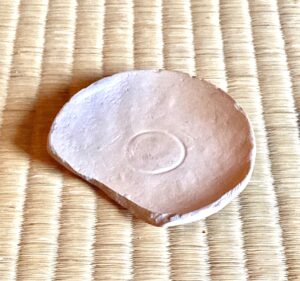
Mae-kawarake, 前土器, fore-earth-container: su-yaki, 素焼き, plain-fired, ceramic saucer for drinking o-mi-ki, お神酒 , hon.-god-sake, from I-se Jin-gū, 伊勢神宮, That-strength God-palace/shrine.
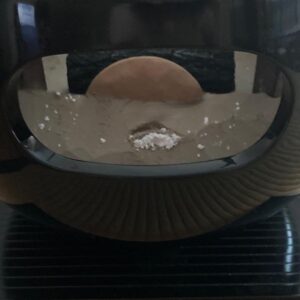
The hi-mado, 火窓The, fire-window, of the mayu bu-ro, 眉風炉, eyebrow wind-hearth, showing the ash bed with the divot in the front partially covered with a fuji-bai moon crescent. The mae-kawarake, 前土器, fore earth-container, is partly revealed above the ash bed crest, with the black charcoal dō-zumi, 胴炭, body-charcoal, behind it. The pictured mae-kawarake is from I-se Jin-gū, 伊勢神宮, That-strength God-palace, dedicated to Amaterasu, the sun goddess.
The mae-kawarake is the ceramic shallow dish that deflects the heat of the fire in the furo. The original kawarake was a low-fired terra cotta saucer for drinking o-mi-ki, お神酒, hon.-god-sake, at a Shintō shrine. Therefore, it retains some Shintō sanctity to bless the fire. Sake is a liquid that could extinguish the fire, if only metaphorically. The supreme deity of Shintō is Ama-tera-su, 天照, Heaven-brightener, the sun goddess, and is worshiped primarily at dawn. The mae-kawarake standing upright emerging from the ash may represent the sun rising.
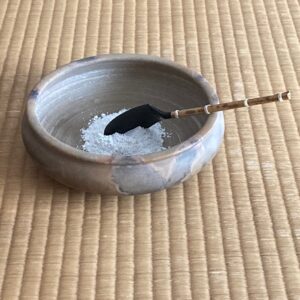
Hai-ki, 灰器, ash-container, shallow, ceramic bowl, un-ge yaki, 雲華焼, cloud-flower fired, marked Ei-raku, 永楽, Ever-pleasure; diam. 6.5 x 1.9 sun kane-jaku. Hai-saji, 灰匙, ash-spoon, black-finished metal spoon with handle wrapped in take-no-kawa, 竹の皮, bamboo-’s-skin, placed on edge in a mound of fuji-bai, 藤灰, wisteria-ash.
The pictured hai-ki, 灰器, ash-container, a shallow, ceramic bowl is used with the fu-ro, 風炉, wind-hearth. When presenting sumi-de-mae, 炭手前, charcoal-hand-fore, in the presence of the guests, a small amount of white fuji-bai, 藤灰, wisteria-ash, is mounded in a hai-ki, 灰器, ash-container. The ash is handled with a hai-saji, 灰匙, ash-spoon. Depending on the style and form of the furo, fuji-bai is sprinkled, maki-bai, 蒔灰, sow-ash, over the ash bed. The fuji-bai is sprinkled lightly in cool weather, and plentifully in very hot weather. The same is true when sprinkling tsuyu, 露, dew, on the lid of the fuchi-daka, 縁高, edge-high, boxes in which sweets are served to the guests.
The fuji-bai may be identified with Buddhist ha-kkotsu, 白骨, white-ashes. The doctrines of Jō-do Shin-shū, 浄土真宗, Pure-land True-sect, called the Go-bun-sho, 御文章, Hon.-literary-article, were written by Ren-nyō, 蓮如, Lotus-like, 8th head of Hon-gan-ji, 本願寺, True-vow-temple. In the chapter, Ha-kkotsu no Shō, 白骨の章, White-ashes Chapter, there is the passage;
‘Asa ni kō-gan arite yūbe ha ha-kkotsu, to nareru mi nari,’
朝には紅顔ありて、夕べには白骨となれる身なり,
Morning in rosy-face have evening white-ashes, so the body becomes.
This passage is read at many funerals in Japan. There follows the instruction to gain salvation through reciting the Nen-butsu, 念仏, Feeling-Buddha, ‘Na-mu A-mi-da Butsu’, 南無阿弥陀仏, South-no Praise-increase-steep Buddha.
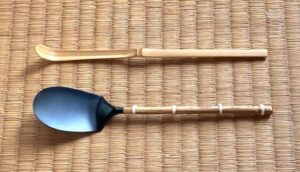
When first building the charcoal fire in the furo, sho-zumi, 初炭, first-charcoal, a small amount of ash, tsuki-gata, 月形, moon-shape, is removed with the hai-saji, 灰匙, ash-spoon, from the front crest face of the ash bed in front of the mae-kawarake, and is placed on the back valley of the ash bed. This ‘moon’ reference helps identify the mae-kawarake with the sun. Moving the crescent moon to the back of the furo, might imply the night. When rebuilding the charcoal fire, 後炭, latter-charcoal, a small amount of fuji-bai is spooned onto the crescent depression in the furo. It is likened to a cloud passing in front of the moon.
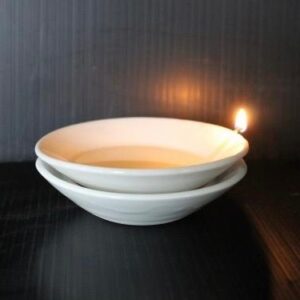
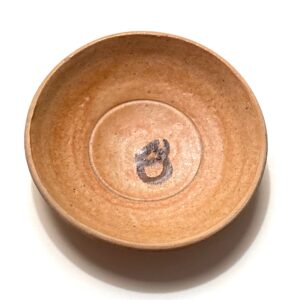
The mae-kawara-ke, 前土器, fore-earth-container, also called mae-kawara, 前瓦, fore-tile, is a half-moon shaped unglazed earthenware shallow disk. There are two types, shiro, 白, white, and aka, 赤, red. The mae-kawarake is imbedded upright in crest of the ash between the gotoku legs and the hi-mado, 火窓, fire window. Once, the himado allowed charcoal and wood to be added to the fire within, but that custom ended, so now the mae-kawarake blocks access to the fire through the window. Usually, the white mae-kawarake is used with the do-bu-ro, 土風炉, earthen-wind-hearth, and the red mae-kawarake is used with the tetsu-bu-ro, 鉄風炉, iron-wind-hearth. With an intense fire, two mae-kawarake may be stacked on top of each other.
The mae-kawarake with its Shintō sake associations, may also have its origins in ceramic oil lamps, especially votive lamps. From ancient times, there have been countless varieties of oil lamps. The lamp is called an abura-zara, 油皿, oil-dish, also called tō-myō-zara, 灯明皿, lamp-light-dish. It may be a single dish or two dishes stacked one upon the other. This type of oil lamp is used in offerings at shrines and temples, and is called a tō-myō, 灯明, lamp-light. The oil should be vegetable oil, such as na-tane abura, 菜種油, rape-seed oil. The oil is burned using a tō-shin, 灯芯, lamp-wick. This style of oil lamp is used in various manners that include being placed by itself, in groups, and within lanterns, tō-rō, 灯篭, lamp-baskets, The dish provides light offered to a god or Buddha.
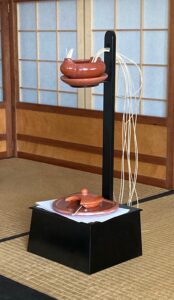
Rikyū’s choice for the abura zara for his tan-kei, 短檠, short-stretcher, was aka-Raku-yaki, 赤楽焼, red-‘Pleasure’-fired.
The small dish to catch drips could be used as a mae-kawarake, however, the mae-kawarake is unglazed ceramic that can withstand the direct heat of the charcoal fire, as glazed ceramic cannot.
The actual oil lamp with wicks has the special name of suzume gawara, 雀瓦, sparrow tile, because of its bulbous form.
The bisque-fired unglazed suyaki type of ceramics is close to terra cotta, which translates to ‘earth bake’. The latter is quite red in color. Suyaki is a light brown, however, some pieces can be somewhat reddish. A related suyaki dish that is identified with fire is the hō-roku, 焙烙, fire-burn, which holds a fire to welcome spirits back home for OBon. A hōroku is used to carry fire building utensils when re-building the charcoal fire in the dai-ro, 大炉, great-hearth, in February.
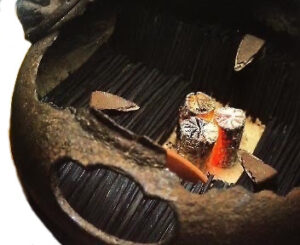
Yatsure bu-ro, 窶れ風炉, time worn wind-hearth, rusted and decomposed iron furo with three pieces of burning charcoal shita-bi, 下火, down-fire, and charcoal blackened rice straw wara-bai, 藁灰, straw-ash, with aka mae-kawarake, 赤前土器, red fore-earth-container. Photo: Sumiyoshi Sadō Kyōshitsu, 住吉茶道教室.
The yatsure bu-ro, 窶れ風炉, time worn wind-hearth, is a large old broken-down iron brazier that is used in the 10th month which is called Kan-na-zuki, 神無月, God-less-month, when Shintō deities leave their shrines and gather at Izumo Tai-sha, 出雲大社, Out-cloud Great-shrine. The Buddhist deities remain in their temples, so that the use of the yatsure buro with the red tō-myō-zara, 灯明皿, lamp-light-dish, lends its Buddhist spirit to the fire. The Buddhist guardian of the 10th month is Amida Nyorai, and perhaps burning incense in the Chinese inspired furo affirms the influence of Buddhism.
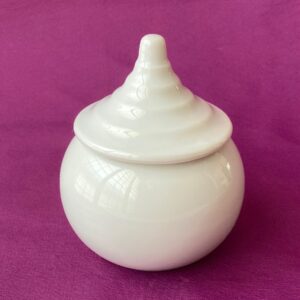
Mizu-tama, 水玉, water-jewel, porcelain vessel with conical lid; H. 2.8 sun kane-jaku. Used to offer water at a Shintō shrine.
The basic Shintō offering is water, which is usually held in a mizu-tama, 水玉, water-jewel. The Shintō mizu-tama is a counterpart of the Buddhist tōmyō-zara. They are both manifestations of the hō-ju, 宝珠, treasure-jewel; diam. 1.8 sun kujira-jaku, which is a representation of combined water and fire, a manifestation of Kū, 空, the Void.
In the realm of Chanoyu, water is physically manifested in the mizu-sashi, 水指, water-indicate, and fire is physically manifested in the furo and ro. In the furo, the mae-kawarake may represent the Shintō mizutama and the Buddhist tōmyō-zara, imbuing the fire with the sanctity of both beliefs.
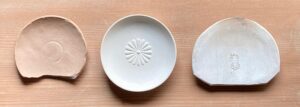
From left: sakazuki, 盃, cup, for drinking o-mi-ki, 御神酒, hon.-god-sake, at a Shintō shrine, su-yaki, 素焼き, plain-fired, pottery; diam. 3 sun kane-jaku. Broken after use – from I-se Jin-gū, 伊勢神宮, That-strength God-palace/shrine.
Center: sakazuki, for drinking omiki at a Shintō shrine, white ceramic with raised design of imperial kiku-mon, 菊紋, chrysanthemum-crest; diam. 3 sun kane-jaku, from Hako-zaki Hachi-man-gū, 筥崎八幡宮, Crate-cape Eight-banner-palace/shrine, Fuku-oka, 福岡, Fortune-hill, Kyūshū. The potter supplies this sakazuki for other shrines across Japan.
Right: mae-kawarake, 前土器, fore-earth-container, low-fired white ceramic disk, Un-ge-yaki, 雲華焼, Cloud-flower-fired, with bevels, by Yama-moto Sō-un, 山本崇雲, Mountain-foot of Revere-cloud; diam. 3.5 sun kane-jaku. Showing the reverse side.
For further study, see also: Tea and Moon Viewing and Furo: Style and Form

